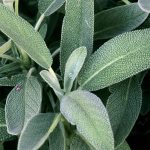 (Colour) grey-green (as in the leaves of Salvia officinalis (sage)).
(Colour) grey-green (as in the leaves of Salvia officinalis (sage)).
An herb with mint-like leaves that may be ground and used to flavor foods.
Sage is a herb from the mint family, with small, rough leaves and purplish flowers. There are around five hundred different varieties, with varying tastes, colors, and smells. The Dalmatian sage is considered the best variety and is grown in the mountains of Serbia and Yugoslavia. It has green leaves that are warm, aromatic, and slightly bitter. Sage is used in many dishes, such as seasoning Dutch cheese, pork, and holiday turkey dressing. However, it can also cause indigestion. In the United States, over two million pounds of sage are used annually.
Within the realm of culinary delights, there exists an herb of bold character, bearing a distinctive, slightly bitter taste. This remarkable herb manifests in various forms, with red and green sage standing out as preferred choices for gastronomic endeavors. Its leaves, whether fresh or dried, grace a multitude of dishes, imparting their flavorful essence to meat preparations, stuffings, cheese, lentil delicacies, soups, and salads. Furthermore, the enchanting flowers of this herb find their place in the realm of salads, contributing an extra touch of charm. In times of yore, sage tea held a prominent position in England’s beverage repertoire, serving as a favored libation prior to the advent of tea. Revered for its perceived mild tonic properties and its ability to soothe a sore throat, this tea was concocted through the infusion of either 3 ounces of fresh sage or 4 ounces of dried sage in 24 cups of boiling water. To suit individual preferences, it was customarily served with sugar and a hint of lemon.
